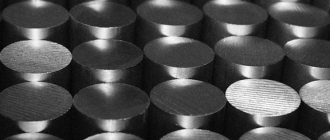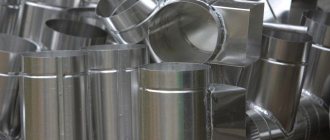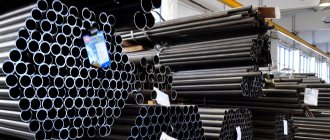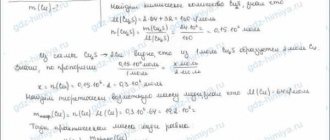Meanwhile, everyone knows that the main disadvantage of iron is precisely its susceptibility to corrosion (especially “acid” corrosion). Therefore, the production of steel alloys that are minimally susceptible to rust and acid corrosion is one of the most important tasks of modern metallurgy.
As for ordinary, “air” corrosion, the recipe for steel that is not susceptible to it was discovered in 1913 by trial and error by the self-taught English metallurgist Harry Brearley. On the eve of the First World War, English steel companies began research into alloys that could be used in the production of guns and gun barrels.
The level of materials science at that time was low, so research was carried out “at random”, and the results of unsuccessful experiments were simply dumped somewhere in the backyard, where they were supposed to rust, awaiting remelting.
Here the discovery took place - when sending the next batch of samples to the furnace, the observant Harry Brearley noticed that one of the castings, after lying in the rain for a month, did not rust and retained its shine. He was not too lazy to find out the time and method of its manufacture: it turned out that the workpiece came out of the electric furnace and contained 85.3% iron, 0.2% silicon, 0.44% manganese, 0.24% carbon and 12.8% chromium. This is how the first stainless steel appeared, which, as it soon became clear, is also resistant to nitric acid. Nowadays, the range of stainless steels by application is very diverse, for example, look here: https://stvybor.ru/nerzhaveyushchij-metall/) .
Later it turned out that the secret of stainless steel is associated with the presence of chromium in its composition: this metal, when in contact with air, forms a strong and transparent oxide film of Cr2O3 that does not dissolve in water.
However, this technological breakthrough was only half the story.
Firstly, not all types of steel have to work in an environment with the presence of oxygen, and where there is no oxygen, a layer of chromium oxide will form slowly or may be destroyed.
Secondly, different acids react with metals in different ways.
Based on their effect on alloys, acids of a non-oxidizing nature (solutions of hydrochloric Hcl and sulfuric acids H2SO4) and oxidizing acids (for example, nitric acid HNO3) are distinguished.
The difference in the interaction of acids with metals is explained by their ionic composition. If the interaction of a metal with an acid anion produces insoluble substances, then the acid resistance will be high. Lead exhibits high resistance to sulfuric acid H2SO4, magnesium – to solutions of fluoric acid HF, iron – to phosphoric acid solutions.
In this case, the acid resistance of one of the alloy components will increase the stability of the entire material, therefore, for different types of acids, steels of different compositions will be required, namely:
Classification of stainless steels by chemical. composition:
— Chrome-nickel Household use, including kitchen utensils
— Austenitic Advantages: High strength, corrosion resistance, ductility, as well as high manufacturability. Applicable: Structural material, welding machines for aggressive environments. Steel types: 300 series. AISI 304 is a universally used steel grade, which is an analogue of 08Х18Н10, contains 8% nickel and 18% chromium. It is resistant to acid and short-term temperature increases up to 1000C. Doesn't magnetize! Application: ventilation, chimneys, storage and transportation of food, chemical reagents. Kitchenware, pipes and architectural field. AISI 316 is an improved analogue of AISI 304 with a chromium content of 16.5 to 18% and a nickel content of 10 to 13%. This combination of AISI 316 significantly improves corrosion resistance in aggressive environments. Increased molybdenum content increases resistance to crevice and pitting corrosion in chlorine, seawater and acetic acid. Higher heat resistance and creep strength. If there is a risk of heat-affected corrosion, it is recommended to use AISI 316L.
— Austenitic-ferritic Advantages: Increased yield strength and excellent weldability. Applicable: Aviation, chemical engineering, shipbuilding. Steel types: 08Х18Г8Н2Т
— Austenito-martensitic Advantages: Manufacturability and increased strength. Steel types: 08Х17Н5М3, 09Х15Н9У, 07Х16Н6, etc.
— Chromium Used for turbine blades, cracking unit fittings, cutting tools, hydraulic press valves, household items, springs, etc.
— Martensitic Advantages: high mechanical properties; good resistance to corrosion in slightly aggressive environments, such as a weak acid solution or a weak alkaline solution. Applications: manufacturing of cutting tools (knives, elastic structures and elements of the chemical and food industries that come into contact with a slightly aggressive environment); Steel types: 40Х13, 30Х13
— Ferritic steels Advantages: resistance to corrosion in nitric acids, aqueous solutions of ammonia, nitrogen mixtures, ammonium nitrate and other highly aggressive environments; Applicable: food industry, light industry, manufacturing of products for oxidizing environments, household appliances, heat exchange equipment in the engineering industry; Steel types: 400 series.
Martensitic steel
This is a stainless alloy with the highest possible strength. Such alloys contain a significant (up to 1%) amount of carbon, which forms a specific microcrystalline structure. Martensitic steels 20X13, 30X13 and 40X13 contain on average about 13% chromium; they easily tolerate contact with weak solutions of organic acids and their salts.
Recently, titanium alloys with palladium (0.2%) and molybdenum (30-35%) are increasingly used. Titanium is generally unstable in acidic environments, but its titanium alloys exhibit high resistance in non-oxidizing acids. This especially applies to alloy 4201. It is stable even in hot sulfuric and hydrochloric acid solutions, and is destroyed only in very concentrated acids. But in nitric and oxidizing acids, alloy 4201 is stable only at low temperatures and low concentrations.
The material was prepared by specialists: https://stvybor.ru/.
Designations of stainless steel grades adopted in fasteners
The fasteners use stainless steel of the austenitic chromium-nickel group, which contains nickel in the composition from 5 to 25% and chromium from 15 to 26%, which gives it high corrosion resistance, and it also has no magnetism (does not magnetize). Steel of the austenitic group is marked with the letter A, followed by a number that determines its composition.
— Steel A2 The closest analogues are AISI 304, GOST 08Х18Н10 - weakly magnetic, corrosion-resistant and non-toxic steel, does not heat up. Easy to weld without brittleness. Begins to magnetize after processing. Fasteners are made from A2 steel for fastening ventilation facades (ventilated facades), stained-glass windows made of aluminum, fences, pumps, in shipbuilding. Temperature range from minus 200 C to 425 C.
- Steel A4 The closest analogues are AISI316, GOST 10Х17Н13М2 - unlike A2, it has 2 - 3% more molybdenum, due to which it better resists the effects of corrosion and acids. It is more antimagnetic compared to A2, 100% non-magnetic. Most often used in the shipbuilding industry, as well as in devices that no longer work correctly with magnetic fasteners. It is acid-resistant stainless steel and is also not afraid of sea salt and bleach. Temperature range from minus 60 C to 450 C.
Application of acid-resistant alloys
Alloys that are highly resistant to “acid” corrosion are used in many industrial areas:
- mining;
- processing;
- pulp and paper;
- aircraft and mechanical engineering;
- instrument making;
- chemical
The material is used for the production of assembly units, parts, and housings of units placed in an aggressive environment. These include sewer pipes, tank linings in industries such as oil and gas, food, and chemical. Industrial smoke exhaust systems, rods, electrodes, forgings, etc. are made from acid-resistant materials. This is also the best option for the production of food grade pipes.
12Х18Н10Т in the form of sheets is used as a finishing and construction material for the manufacture of vessels operating under high pressure conditions. It is used in cryogenic technology at very low (down to -269⁰) and extremely high temperatures (in arc furnaces).
Equipment used in the production of synthetic rubber, isoprene, synthetic acetic acid, and ethanolamines is made from steel 10Х17Н13М2Т. The housings of the equipment in which gemstone crystals are grown under artificial conditions are also made from this material.
Stainless steel strength class A2, A4
For example, the designation on the head: A2-70, A4-70
| Group | steel grade | Diameters, mm | Strength class | Tensile strength, N/mm2 | Limit fluidity N/mm2 | Elongation at break, mm |
| Austenitic | A2, A4 | up to M39 incl. | 50 | 500 | 210 | 0.6d |
| Austenitic | A2, A4 | up to M24 incl. | 70 | 700 | 450 | 0.4d |
| Austenitic | A2, A4 | up to 24 incl. | 80 | 800 | 600 | 0.3d |
Acids resulting from fuel combustion
Sulfuric acid is formed by the interaction of sulfuric anhydride SO3, contained in the exhaust gases of heat generators, especially those operating on diesel fuel, and water vapor:
SO3+ H2O <=> H2SO4
Nitric acid. When nitrogen dioxide released during the combustion process interacts with the resulting water vapor, nitric acid is formed:
2NO2+ H2O <=> HNO3+ HNO2
Carbonic acid is formed as a result of the interaction of water-soluble carbon dioxide and water vapor:
CO2 + H2O <=> H2CO3
Chemical composition of stainless steel
| Brand | Chromium | Nickel | Molybdenum | Copper | Phosphorus | Selenium |
| A1 | from 16 to 19% | from 5 to 10% | 0,7% | from 1.75 to 2.25% | 0,200% | from 0.15 to 0.35% |
| A2 | from 15 to 20% | from 8 to 19% | — | 4% | 0,050% | 0,03% |
| A3 | from 17 to 19% | from 9 to 12% | — | 1% | 0,045% | 0,03% |
| A4 | from 16 to 18.5% | from 10.5 to 14% | from 2 to 3% | 1% | 0,045% | 0,03% |
| A5 | from 16 to 18.5% | from 10.5 to 14% | from 2 to 3% | 1% | 0,045% | 0,03% |
Articles about products Updated: 12/08/2020 14:52:03
Percentage of chemical compounds in combustion products
| Type of fuel | NO2 (nitrogen dioxide) | SO3 (sulfur oxide) | CO2 (carbon dioxide) | W (humidity) |
| Wood | 0.5% | — | 90% | 6% |
| Natural gas | — | — | 90% | 10% |
| Diesel fuel | — | 3% | 90% | 10% |
| Coal | 1% | 3% | 90% | 6% |
Technological properties
Taking into account the chemical composition of AISI 321 steel and its mechanical, physical, chemical characteristics, the technological properties of the structural material are as follows:
· malleability – low;
· hardenability – low;
· fluidity – low;
· cutting machinability – high;
· weldability – without restrictions and preheating of edges.
AISI 321 steel is welded with special electrodes of the 347 series, stabilized with niobium. Welds are cleaned and passivated to prevent corrosion in the heat-affected zone.
AISI 321 material is annealed in the temperature range +1050°C ... +1150°C, followed by cooling in air. The tempering temperature is +450°С ... +800°С. For passivation, a temperature of +20°C and a HNO3 solution of 25% concentration are used.
The specified chemical composition for AISI 321 with a chromium and nickel ratio of 18/8 provides a rational combination of strength characteristics, production costs, anti-corrosion properties and product life.
Mechanical properties
The mechanical characteristics of steel for AISI 321 correspond to the following values:
· elasticity – elastic modulus 193 GPa;
· ductility – relative elongation 40%;
· viscosity – yield strength 205 MPa;
· strength – fatigue 240 N/mm2, tensile strength 515 MPa;
· hardness – 170 Brinell units.
A short 30 cm rod of stainless steel 321 with a thickness of 8 mm can be bent by hand, since the hoist is quite soft. During turning, chips are removed easily, with low energy consumption and labor costs. The thread has a smooth profile, without torn edges or burrs. However, AISI 321 threaded connections are most often disposable - with a high tightening force, the thread profile is deformed.
AISI 321 GOST taxes are applied to two construction materials at once - 12Х18Н10Т and 08Х18Н10Т. For AISI 321 steel, the standard includes its only modification 321H with an extended carbon content range.
Physical properties
Chromium-nickel austenitic stainless steel AISI 321 has the following physical type characteristics:
· specific heat capacity – 504 J/kg*°C;
· fusibility – stainless steel AISI 321 melts at +1400°С ... +1455°С;
· electrical resistance – 1.5*10-6 Ohm*m;
· weight – AISI 321 density 7900 kg/m3;
· thermal conductivity – coefficient for AISI 321 stainless steel is 17 W/m*°C;
· expandability – AISI 321 stainless steel has a linear expansion coefficient of 16 – 18 1/°С;
· magnetization – AISI 321 material does not contain ferrite in its structure, does not have magnetic properties;
· color – steel grade AISI 321 has a steel color;
· electrical conductivity – AISI 321 steel has an indicator of 1 – 1.2%IACS;
In the three hundredth austenitic series of corrosion-resistant alloys, AISI 321 stainless steel, by analogy with standard 304, can be called both food and medical stainless steel. Because it is used to make dishes, milk couplings, surgical instruments, and medical autoclaves.
The surface of the metal does not need to be chromed or nickel plated, since both of these metals are already present in the structure of the 321 alloy. Therefore, rolled pipes are widely used in construction, finishing of facade exteriors and interior interiors.
Classification of properties
For all structural materials of the metal group in the Russian Federation, a classification of their characteristics is used according to four main criteria:
· physical characteristics - weight and fusibility, color and expandability, magnetization and electrical conductivity, thermal conductivity;
· chemical properties - solubility, corrosion resistance and oxidation;
· mechanical characteristics - plasticity, viscosity, strength, elasticity and hardness;
· technological properties - malleability and hardenability, weldability and machinability, fluidity.
Additionally, stainless steels are classified within their own steel category according to the following characteristics:
· corrosion-resistant – do not rust under atmospheric conditions;
· heat-resistant – do not oxidize at high temperatures and do not form scale;
· heat-resistant – work for a long time under load at high temperatures;
· acid-resistant – do not rust in acidic environments;
· cold-resistant – retain viscosity at subzero temperatures.
Basically, 321 steel is 304 stainless steel with the addition of 0.5% titanium. Which corresponds to domestic analogues 08Х18Н10 and 08Х18Н10Т.









